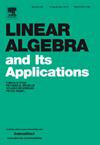Numerical methods for eigenvalues of singular polynomial eigenvalue problems
IF 1
3区 数学
Q1 MATHEMATICS
引用次数: 0
Abstract
Recently, three numerical methods for the computation of eigenvalues of singular matrix pencils, based on a rank-completing perturbation, a rank-projection, or an augmentation have been developed. We show that all three approaches can be generalized to treat singular polynomial eigenvalue problems. The common denominator of all three approaches is a transformation of a singular into a regular matrix polynomial whose eigenvalues are a disjoint union of the eigenvalues of the singular polynomial, called true eigenvalues, and additional fake eigenvalues. The true eigenvalues can then be separated from the fake eigenvalues using information on the corresponding left and right eigenvectors. We illustrate the approaches on several interesting applications, including bivariate polynomial systems and ZGV points.
奇异多项式特征值问题特征值的数值方法
近年来,提出了基于秩完备摄动、秩投影和增广的奇异矩阵铅笔特征值的三种计算方法。我们证明这三种方法都可以推广到处理奇异多项式特征值问题。这三种方法的公分母是将一个奇异多项式转化为一个正则矩阵多项式,其特征值是奇异多项式的特征值的不相交并,称为真特征值,以及附加的假特征值。然后可以使用相应的左特征向量和右特征向量上的信息将真特征值与假特征值分开。我们在几个有趣的应用中说明了这些方法,包括二元多项式系统和ZGV点。
本文章由计算机程序翻译,如有差异,请以英文原文为准。
求助全文
约1分钟内获得全文
求助全文
来源期刊
CiteScore
2.20
自引率
9.10%
发文量
333
审稿时长
13.8 months
期刊介绍:
Linear Algebra and its Applications publishes articles that contribute new information or new insights to matrix theory and finite dimensional linear algebra in their algebraic, arithmetic, combinatorial, geometric, or numerical aspects. It also publishes articles that give significant applications of matrix theory or linear algebra to other branches of mathematics and to other sciences. Articles that provide new information or perspectives on the historical development of matrix theory and linear algebra are also welcome. Expository articles which can serve as an introduction to a subject for workers in related areas and which bring one to the frontiers of research are encouraged. Reviews of books are published occasionally as are conference reports that provide an historical record of major meetings on matrix theory and linear algebra.

 求助内容:
求助内容: 应助结果提醒方式:
应助结果提醒方式:


